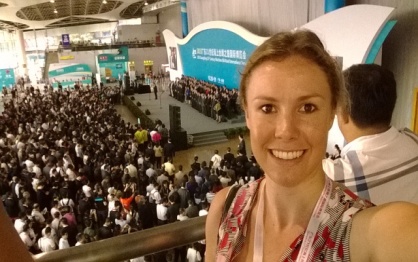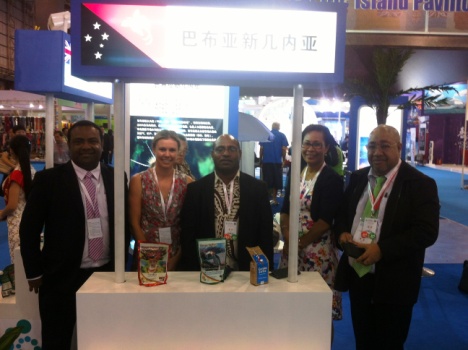Pacific Islands Trade & Invest 'Southern China Mission'
- Pacific Legal Network

- Nov 30, 2015
- 5 min read
Key Takeaways and Themes
China is positioning itself to play a greater role in global affairs by building a sophisticated trade and infrastructure network, through its One-belt-one Road and the 21st Century Maritime Silk Road Strategy.
While there are trading and investment opportunities, China and the Pacific must work together to improve connectivity through aviation and shipping.
Patience is key – China is not a quick business or investment solution and building strong business partnerships takes time.
Introduction In late October, I returned to Southern China to take part in the Pacific Islands Trade & Invest Southern China Mission 2015 (Mission). Having spent a couple of years previously working and studying in China, it was a great opportunity to re-connect with China and represent the Pacific Legal Network (and the broader Pacific community) on the 5 day Mission covering Hong Kong, Shenzhen and Guangzhou. The Mission was a chance to meet Chinese businesses keen on doing business in the region, to learn about key policy developments which will affect Pacific Businesses as well as some of the opportunities and challenges that will be faced by the Pacific in pursuit of greater business-to-business exchange with China. Here’s a snapshot of the action-packed 5 day tour:

Day 1: Hello Hong Kong
Of course no trip to Hong Kong would be complete without a ride on the Star Ferry between Hong Kong Island and Tsim Sha Tsui and gorging over Yum Cha at Maxims. Tick. Tick. Having sufficiently fuelled myself with dumplings, the Mission kicked-off with a delegate business briefing, covering aspects of doing business in China and Hong Kong. I was fortunate to present on the panel along with Bejamin Yau (Hong Kong Trade and Development Council) and David Fraser (Flights Centre, Managing Director, (Greater China)) on some of the legal and regulatory issues to think about when doing cross-border business with China.

Day 2: Shaking-up Shenzhen The Mission spent an action packed day in Shenzhen where we were hosted by Shenzhen government leaders and the Shenzhen China Council for the Promotion of International Trade. Here, we were able to explore opportunities between the Shenzhen region, to hear from Pacific and Chinese businesses about opportunities and challenges, success stories and for delegates to meet over business matching sessions with Shenzhen businesses.
Days 3 & 4: Greetings from Guangzhou Days 3 & 4, were no less intense during our visit to Guangzhou. Highlights included:
a visit to the Opening Ceremony of the 21st Century Maritime Silk Road Expo in Dongguan, which showcased China’s One-belt-one-road, and 21st Century Maritime Silk Road Strategy;
business matching sessions with local Guangzhou businesses; and
a policy roundtable discussion with Chinese experts on China-Pacific studies at Sun Yat Sen where participants had the opportunity to flesh-out challenges and opportunities for greater business engagement between China and the Pacific.
Day 5: Farewell from the fair

We rounded out our China adventure with a stop at the Canton Fair (one of the largest trade shows in the world) to visit the Pacific Island booth, before boarding the train to Hong Kong.
Opportunities and Challenges for Pacific businesses when doing business with China
Tourism During the Mission a key area of focus for greater cooperation was in Tourism. The beautiful Pacific Island countries offer some of the world’s best beaches and oceans for relaxed (or adventure) holiday making and with China’s rise in global tourism numbers, the Pacific could be set to benefit. However, with few direct flights between China and the Pacific nations, connectivity remains a stumbling block to greater flows of tourists to the region. Central to greater tourism connectivity is aviation, and underpinning this, air services agreements (ASAs). The entry into ASAs with China could mean greater tourism numbers through providing easier access and by driving competition in the aviation industry. On the other hand however, due to the ability of Chinese carriers to offer reduced fares, local carriers (many of which are state-owned) could be impacted. These local airlines cannot offer the same competitive pricing and frequency of flights compared with larger carriers. Already China has been in discussion with Fiji in relation to an ASA between Beijing and Nadi (yet to be enacted), however there remains concern about the potential for Chinese airlines to negatively impact on Fiji’s national carrier (Fiji Airways).[1] Similarly, any discussion on a significant increase in tourism numbers needs to be countered by the idea of sustainable infrastructure development to support greater tourism flows. Because tourists visit the Pacific for its pristine beaches and beautiful culture, without a tempered plan and considered conversation about how to further develop the tourism industry, mass tourism liberalisation has the potential to undermine the very things tourists love about the region. Pacific Export Products During the Mission, many of the Pacific Islands niche products were also on display including noni, cocoa and breadfruit flower. Having the opportunity to visit the Maritime Silk Road Expo it became evident that while the Pacific offers some truly unique products, the Pacific faces challenges to greater trading ties. These include:
the fact that China demands such large volumes of product;
the Pacific faces greater logistical export constraints when compared with other regions; and
the fact that the Pacific is just one of many regions vying for China’s trading attention.
In this regard Pacific businesses would benefit from ‘keeping it niche’, which would require investment in intellectual property (through brand building and marketing). We also heard from a Chinese business who has successfully imported and marketed noni to the Chinese domestic market – this business line was developed over approximately a decade and shows that while niche Pacific products can achieve success; patience is key. China’s One-Belt-One-Road Initiative and 21st Century Maritime Silk Road Strategy China is positioning itself to play a greater role in global trading through its ‘One-belt-one-road Initiative’ and the 21st Century Maritime Silk Road Strategy (Maritime Strategy). These policies aim to create sophisticated global trading channels through road, rail, air and sea networks, created through (among other things) infrastructure development projects (and financed by China’s Asia Infrastructure Investment Bank).[2] The plan unveiled by China is ‘light on detail’[3] and just how the Pacific can be a part of the Maritime Strategy remains to be ‘fleshed out’. While the Pacific’s geographical global positioning, its large sea mass, its fish stocks as well as mineral resources seemingly make it a logical participant in the Maritime Strategy[4], the particulars on the Maritime Strategy are likely to become clearer when China implements its 13th Five Year Plan next year. Notwithstanding the economic opportunity that is presented to the Pacific through the Maritime Strategy, the Maritime Strategy in and of itself marks an interesting time in Pacific affairs as it presents the Pacific with a chance to restate its purpose and regional priorities, amidst what will arguably be a new world order.[5]

Download the article here.
[1] See Fiji Government Website, <http://www.fiji.gov.fj/Media-Center/Press-Releases/PM-IN-CHINA--DISCUSSES-TRADE,-AVIATION-AND-CLIMATE.aspx?feed=news>, accessed on or around 20 November 2015. [2] See further discussion in “’One belt, one road’ initiative will define China’s role as a world leader’ SCMP editorial, 2 April, 2015,< http://www.scmp.com/comment/insight-opinion/article/1753773/one-belt-one-road-initiative-will-define-chinas-role-world>, accessed 24 November 2015. [3] See further discussion in, “One belt, one road? China’s community of common destiny”, post by ‘Philippa Brant, 31 March 2015, <http://www.lowyinterpreter.org/post/2015/03/31/One-belt-one-road-Chinas-community-of-common-destiny.aspx>, accessed on or around 24 November 2015, [4] See extract of speech by David Morris, Trade Commissioner Pacific Islands Trade & Invest, “Building a sustainable Maritime Silk Road to the Pacific”, published 11 October, 2015, full link: <http://davidmorrisprojects.com/news/building-a-sustainable-maritime-silk-road-to-the-pacific/>, accessed on or around 24 November 2015. [5] See comment by Arnie Saiki in response to ‘What China’s ‘Belt and Road’ Initiative means for the Pacific’, by Kalafi Moala, Pacific Institute of Public Policy, <http://pacificpolicy.org/2015/11/what-chinas-belt-and-road-initiative-means-for-the-pacific/>, accessed 24 November 2015. Image obtained from HKTDC, see http://china-trade-research.hktdc.com/business-news/article/Research-Articles/One-Belt-One-Road-Initiative-The-Implications-for-Hong-Kong/rp/en/1/1X3A3JKV/1X0A23WV.htm





































